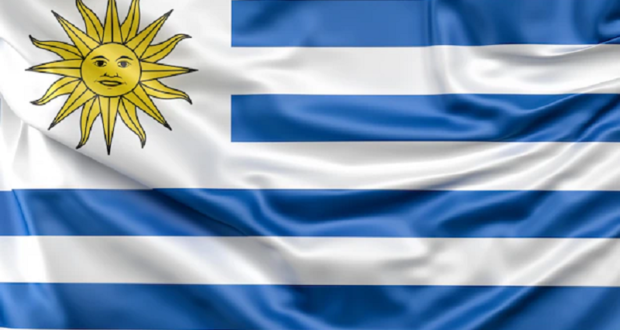The Iconic Flag of Uruguay: A Symbol of Independence
Uruguay’s iconic blue and white striped flag is a bold and symbolic representation of the country’s flag of uruguay hard fought independence and the prideful spirit of its people.
Known as the Sun of May or Sol de Mayo flag, Uruguay’s vibrant national emblem draws
from symbolic meaning and history to represent national concepts of liberty, sovereignty, and the memory of fallen patriots.
Meaning Behind the Powerful Design
The flag of Uruguay sports a familiar design to many, with nine horizontal
alternating stripes of white and blue. But inside this seemingly simple banner lies profound meaning and symbolism.
The Nine Stripes
The most distinctive aspect of the Uruguayan flag is likely the nine
equal stripes in white and blue that form the background. These stripes were significant from the very origins of the flag.
According to Uruguayan tradition, the nine stripes represent the nine original territories or departments that first declared independence from the Brazilian Empire in 1825.
The nine stripes are: Artigas, Canelones, Cerro Largo, Durazno, Maldonado, Montevideo, Paysandú, San José and Soriano.
Displaying nine stripes on the national standard pays tribute to these founding
provinces that ignited the fight for Uruguayan nationhood.
The alternating white and blue pattern also connects to the national colors of the country, used in the oriental standard or cockade banner during the early revolution.
The white symbolizing peace and blue symbolizing vigilance, truth and loyalty.
The Sun of May
In the top hoist canton of Uruguay’s flag sits a glowing emblem – a yellow Sun of May, also called the Sun of Victory. This powerful icon at the heart of the flag has its origins in the banner carried by General José de San Martín during
the Argentine War of Independence.
It depicts Inti, the Inca God of Sun, with a face at its center surrounded by radiating triangular rays alternatively pointed up and down.
This Inti sun figure is framed in an oval wreath.
Uruguay’s adoption of the sun in its national flag represents fraternity with Argentina in their allied fight against imperial rule during the revolutionary wars.
It stands as a symbol of freedom from oppression.
The National Motto
Capping off the symbolic details of the Uruguayan flag is its national motto elegantly inscribed along the white stripe running through the blue center stripe:
“Libertad o Muerte”
This means “Freedom or Death” in English, reminding of the ultimate sacrifice
for liberty that Uruguay’s forefathers were willing to pay for national autonomy.
The relates to the Thirty-Three Immortal Orientals who gave up everything to cross back over the Uruguay River and fight for independence from Empire del Brasil.
Liberty or death was their rallying call.
The flag of uruguay That Came Before – Beginnings of an Identity
The iconic blue-white-blue striped flag proudly waving in the sea breeze on the beaches of Punta del Este came from more humble beginnings.
Tracing its history takes us back to a burgeoning Uruguayan national identity.
Birth of the Eastern Band
In 1825, in the windswept plains of southern Brazil a troop of defiant patriots bound themselves in brotherhood against the Empire del Brasil.
Theycalled themselves
“The Thirty-Three Orientals” – making reference to their origins across the eastern bank (‘oriental’ meaning eastern) of the Uruguay river.
The Thirty-Three Orientals Cross the Uruguay River – Painting by Juan Manuel Blanes
This dedicated group were led by the revolutionary Juan Antonio Lavalleja and vowed to bring independence to the lands that would become Uruguay.
Stories tell of these brave thirty-three revolutionaries crossing the Uruguay River carrying a blue and white oriental standard banner into battle.
This early standard flag, created by Lavalleja’s mistress –
Maria de las Nieves, featured blue and white stripes with an upper red triangle symbolizing the
Federal League pact between Uruguay and Argentina provinces against Brazil.
Declaration of Independence
By August 1825, the oriental rebellion had built momentum, first under the protection of the United Provinces of Rio de la Plata (Argentina) then under Fructuoso Rivera’s command when Lavalleja was injured.
After winning the Battle of Rincón,
the independence faction felt bold enough to declare Uruguay’s freedom. On August 25, 1825 at La Florida, the newly self-proclaimed leaders let the blue and
white striped oriental standard fly high as they announced Uruguay’s independence.
While used proudly in those opening moments of liberation,
the oriental standard was not yet the official national flag we know today.
flag of uruguay of uruguay Adoption as National Flag
After further turmoil in the Great War and shifting political landscapes, independence was finally cemented on August 28, 1828 with the signing of the Preliminary
Peace Convention between Brazil and the newly formed Eastern Republic of Uruguay.
With sovereign autonomy now realized, the quest began to find an appropriate flag to represent this nascent state.
First Version – Nine Stripes and Sun of May
In December 1828, Uruguay’s National Constitutional Convention addressed defining a fitting flag for their republic.
Accounts vary, but motivated by the early oriental standard, they officially adopted the now iconic nine striped design with alternating white and blue – symbolizing peace and vigilance.
In the upper corner they added the Inti Sun of May icon, showing eastern solidarity with Argentina. “Libertad o Muerte” was emblazoned in the center to seal its power as a true symbol of Uruguayan identity and autonomy.
One of the Earliest Versions of the Uruguayan Flag
This first Uruguayan national flag clearly drew heavy inspiration from Lavalleja’s original standard of blue and white stripes. Just with added embellishments to make it fully unique as its own proud banner.
Sun Variations Over Time
While the basic design elements were established, the exact details of the central Sun of May emblem continued to shift in subsequent decades.
There were debates whether to include the Inti sun face, have triangular or wavy rays, include the oval ring, and vary the number of rays represented. Early variations showed anywhere between 12 to 18 rays.
Some Notable Sun of May Variations Through History
It wasn’t until July 11, 1830 that a National Decree formally defined an official format: a golden 16 ray sun.
But even despite legal definitions, the Sun of May still appeared in alternative forms on various national flags used over the 19th and 20th centuries.
Current Official Flag
Finally on July 11, 2018 – coinciding with the 188th anniversary of the first decree,
a new law was passed to re-establish official specifications for the national flag and seal of Uruguay, putting to rest future variations.
The law standardized the design that Uruguayans would come to know intimately –
the iconic nine striped banner with golden Inti Sun centered in a white oval and 16 triangular rays extending, 8 pointed up and 8 pointed down. Just as it proudly waves today across the prosperous country.
Current Official Flag of Uruguay
What the Flag of uruguay Represents to Citizens
For Uruguayans, their beloved flag flying embodies deeply personal meanings about independence, freedom, and national pride.
Celebrations & Events flag of uruguay
The sky lights up with powder blue and white each summer during Carnival festivities as Uruguayans proudly wave flags, sing folk songs, and dance Candombe in the streets.
Locals display the national banner over balconies or carry mini flags as they party the nights away leading up to Lent.
During emotionally charged soccer matches, fans paint half naked bodies in blue and white,
furiously wave flags, and don replica jerseys to cheer on the Celeste national team alongside the symbolic flag.
Passionate Soccer Fans Rally Around the Flag
During moments of national achievement or loss, the sight of their flag resonates feelings of shared identity, destiny and purpose.
Patriotic Fervor flag of uruguay flag of uruguay
Uruguayans have deep respect for their flag and what it embodies about national struggle and autonomy.
The act of flying it feels like an extension of their freedom-fighting patriotism and pride in country.
A Uruguayan will likely tear up seeing their flag raised abroad or have heart swelled when hearing their anthem ring out amongst other proud countries.
Honor & Remembrance flag of uruguay
On Flag Day December 16th, Uruguayans honor national memory and
sacrifice by reflecting on the orientals who gave their lives to fly their own sovereign standard.
During funerals for heads of state or commemorations,
the sight of the flag lowered or draped evokes visceral emotions for this shared symbol of Uruguayan identity and its tremendous costs over history to protect.
Interesting Flag Facts & Curiosities
Beyond the essential facts around meanings and origins, here are some bonus tidbits about the iconic Uruguay flag:
- At 60 meters long and 30 meters wide (270 square meters), Uruguay holds the Guinness World Record for the largest flag ever flown in the world! This massive banner that could blanket a soccer field was unfurled in Montevideo 2011 using three 20 ton cranes.
- Many visitors mistake Uruguay’s flag for Argentina’s flag from afar, but look closely to spot the difference with 9 vs 3 bold stripes.
- In Durazno there is a 20 meter tall glowing monument of the Uruguayan flag that emanates a colorful light show honoring national pride each evening.
Unique Nighttime Flag Sculpture
- Their proud and history-filled flag has become so central to Uruguayan identity that the country registered trademarks around commercial use of flags with logos containing iconic elements like the Sun of May, stripes and motto.
Lasting Meaning and Legacy flag of uruguay
The iconic Uruguay flag flying fearlessly across the world remains deeply meaningful as a living piece of history and symbol of the country’s victorious fight for freedom and democracy.
Whether seen flapping in the summer winds along the golden coastline, or painted with pride on faces at feverish matches under stadium lights –
the iconic Sun of May flag still powerfully captures the indomitable national spirit of Uruguay.
Through its rich symbology, the light blue and white bands tell a story of struggle, solidarity, visionary leadership, brotherhood, sacrifice and ultimately,
the thrill and responsibility borne from achieving liberty.
Almost 200 years on from those first oriental patriots crossing the Uruguay River carrying their rebel standard – present day Uruguayans can stand tall behind their official flag inherited from such valor and origins.
A flag forever linked to national memory, identity and purpose –
destined to fly high and proud beside the community of free nations to the end of days.
 Living There
Living There




